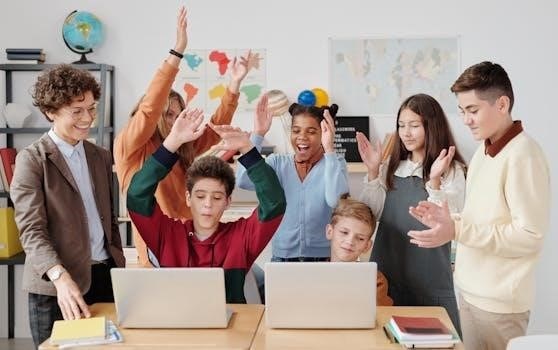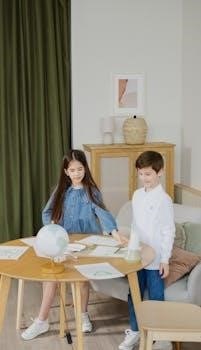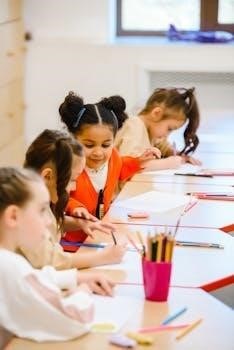Getting to Know You Activities for Students⁚ A Comprehensive Guide
Welcome to a world of connection! This guide dives into the realm of “getting to know you” activities, providing educators with a treasure trove of resources․ Discover printable worksheets, interactive games, and digital tools designed to foster classroom community and engagement․
Starting a new school year or welcoming new students into an existing class often presents a unique challenge⁚ fostering a sense of community and rapport․ “Getting to know you” activities serve as invaluable tools to break the ice, encourage interaction, and establish a positive classroom environment where students feel comfortable sharing and connecting with one another․ These activities are not merely icebreakers; they are foundational elements in building a supportive learning community․
The primary goal of these activities is to facilitate introductions and help students learn about each other’s backgrounds, interests, and personalities․ This initial exploration lays the groundwork for stronger relationships and a more cohesive classroom dynamic․ By participating in structured and engaging activities, students can overcome initial anxieties and begin to form bonds with their peers․
“Getting to know you” activities can take various forms, from simple question-and-answer sessions to more elaborate games and group projects․ The key is to select activities that are age-appropriate, inclusive, and aligned with the specific goals of the classroom․ When implemented effectively, these activities can transform a group of individuals into a collaborative and supportive learning community․
Benefits of Using “Get to Know You” Activities
Integrating “Get to Know You” activities into the classroom provides a multitude of benefits that extend far beyond simple introductions․ These activities are instrumental in fostering a positive and inclusive learning environment, enhancing student engagement, and promoting social-emotional development․ By creating opportunities for students to connect on a personal level, teachers can cultivate a sense of belonging and community within the classroom․
One of the primary benefits is the reduction of anxiety and awkwardness often associated with new beginnings․ Icebreaker activities help students relax, open up, and feel more comfortable interacting with their peers․ This, in turn, leads to increased participation and a more collaborative learning atmosphere․ Furthermore, these activities promote empathy and understanding as students learn about each other’s unique backgrounds, interests, and perspectives․
Moreover, “Get to Know You” activities can significantly improve classroom management․ When students feel connected to one another and to the teacher, they are more likely to be respectful, cooperative, and engaged in learning․ These activities also provide valuable insights into students’ learning styles and preferences, enabling teachers to tailor their instruction to meet individual needs․ The result is a more supportive and effective learning environment for all students․
Types of “Get to Know You” Activities
The realm of “Get to Know You” activities is vast and varied, offering a diverse range of options to suit different age groups, learning styles, and classroom environments․ From simple icebreakers to more elaborate projects, these activities can be tailored to meet the specific needs of your students and curriculum․ Understanding the different types of activities available is key to selecting the most effective ones for your classroom․
One common type is worksheet-based activities, which provide a structured format for students to share information about themselves․ These worksheets often include questions about their interests, hobbies, and favorite things․ Interactive games and icebreakers are another popular choice, encouraging students to engage with each other in a fun and informal way․ These activities can range from simple name games to more complex challenges that require teamwork and communication․
In today’s digital age, digital “Get to Know You” activities are becoming increasingly popular․ These activities can include online surveys, virtual scavenger hunts, and collaborative digital projects․ “Find Someone Who” scavenger hunts are a classic activity that encourages students to mingle and discover common interests․ Finally, classmate interview activities provide students with the opportunity to practice their interviewing skills while learning about their peers․ Each type offers a unique way to foster connection and build community in the classroom․
Worksheet-Based Activities
Worksheet-based activities offer a structured and accessible approach to “Get to Know You” exercises․ These activities typically involve students completing a printed or digital worksheet with prompts designed to elicit personal information and preferences․ The strength of these activities lies in their simplicity and adaptability, making them suitable for a wide range of age groups and learning environments․ They provide a comfortable starting point for students who may be hesitant to share openly in a group setting․

Common prompts on these worksheets include questions about favorite hobbies, subjects, foods, and aspirations․ Some worksheets may also incorporate creative elements, such as drawing prompts or fill-in-the-blank stories․ The key is to design worksheets that are engaging, age-appropriate, and reflective of the classroom’s overall goals․ For younger students, worksheets can be visually appealing with colorful illustrations and simplified language․ Older students may benefit from more open-ended questions that encourage critical thinking and self-reflection․
Teachers can use the information gathered from these worksheets to gain valuable insights into their students’ backgrounds, interests, and learning styles․ This information can then be used to tailor instruction, create personalized learning experiences, and foster a stronger sense of connection within the classroom․ Worksheets can also serve as a springboard for further discussion and activities, allowing students to share their responses and learn more about their peers․
Interactive Games and Icebreakers
Interactive games and icebreakers inject energy and excitement into “Get to Know You” activities, fostering a dynamic and engaging learning environment․ These activities encourage active participation, communication, and collaboration among students, breaking down barriers and building camaraderie․ The goal is to create a fun and relaxed atmosphere where students feel comfortable sharing information about themselves and connecting with their peers․
Popular interactive games include “Two Truths and a Lie,” where students share three “facts” about themselves, two true and one false, and classmates guess which statement is the lie․ “Human Bingo” involves students finding classmates who match specific criteria listed on a bingo card․ “Would You Rather” presents students with thought-provoking choices, sparking lively discussions and revealing personal preferences․ “Speed Dating” pairs students for brief conversations, allowing them to quickly learn about one another․

Effective icebreakers are typically short, simple, and require minimal preparation․ “Name Games,” where students add an adjective to their name, help with memorization and create a playful atmosphere․ “Common Ground” challenges students to find shared interests with their classmates․ These activities encourage interaction, communication, and discovery, helping students forge connections and establish a positive classroom climate․ The key is to select games and icebreakers that align with the age, interests, and learning objectives of the students․
Digital “Get to Know You” Activities

In today’s technologically driven world, digital “Get to Know You” activities offer an engaging and versatile approach to fostering connections among students․ These activities leverage online platforms and tools to create interactive experiences that cater to diverse learning styles and preferences․ Digital activities can be particularly beneficial in virtual or hybrid learning environments, where physical interaction is limited․
One popular option is using online survey tools like Google Forms or SurveyMonkey to create questionnaires that gather information about students’ interests, hobbies, and learning styles․ These surveys can be easily shared and analyzed, providing valuable insights for teachers․ Interactive presentations, created with platforms like Google Slides or PowerPoint, can incorporate polls, quizzes, and collaborative brainstorming activities to engage students in a fun and interactive way․
Virtual whiteboards, such as Padlet or Jamboard, allow students to share ideas, images, and videos in a collaborative online space․ These platforms can be used for activities like “All About Me” collages or virtual icebreakers․ Video conferencing platforms like Zoom or Google Meet can facilitate virtual “Show and Tell” sessions, where students share personal objects or stories with their classmates․ Digital tools offer a wide range of possibilities for creating engaging and effective “Get to Know You” activities that cater to the needs of today’s students․
“Find Someone Who” Scavenger Hunts
“Find Someone Who” scavenger hunts are a dynamic and engaging way to encourage student interaction and discovery․ This activity involves creating a worksheet or checklist with various prompts or characteristics, such as “Find someone who loves to read,” “Find someone who has traveled to another country,” or “Find someone who plays a musical instrument․” Students then circulate around the classroom, interacting with their peers to find individuals who match the descriptions․
As students identify classmates who fit the criteria, they can ask follow-up questions to learn more about them․ This encourages active listening and promotes deeper connections․ “Find Someone Who” activities can be adapted for different age groups and subject areas․ For younger students, the prompts can be simpler, focusing on basic interests and hobbies․ For older students, the prompts can be more challenging, exploring academic interests, personal goals, or life experiences․
The activity can be structured as a competition, where students earn points for each classmate they find who matches a description․ Alternatively, it can be designed as a collaborative effort, where the goal is for the entire class to complete the scavenger hunt together․ “Find Someone Who” scavenger hunts are a fun and effective way to break the ice, encourage interaction, and help students learn about each other’s unique qualities and experiences․
Classmate Interview Activities
Classmate interview activities provide a structured framework for students to connect on a more personal level․ These activities involve pairing students together, with each student taking turns interviewing their partner․ The interview can be guided by a pre-determined set of questions or prompts designed to elicit information about their partner’s interests, experiences, and perspectives․
The questions can range from simple inquiries about favorite hobbies and foods to more thought-provoking prompts about aspirations and challenges․ After the interview, students can then introduce their partner to the class, sharing what they learned during the interview․ This not only helps students get to know each other but also develops their active listening, communication, and presentation skills․
Classmate interviews can be adapted to suit different age groups and learning objectives․ Younger students can focus on basic facts and preferences, while older students can explore more complex topics and opinions․ To add a creative twist, students can create visual representations of their partner based on the interview, such as drawings or collages․ Classmate interview activities are a valuable tool for fostering empathy, building relationships, and creating a supportive classroom environment․
All About Me Collages and Posters
“All About Me” collages and posters are visually engaging activities that allow students to express their individuality and share aspects of their lives with classmates․ These projects encourage students to gather images, words, and mementos that represent their interests, hobbies, family, and personal experiences․
Students can create their collages or posters using a variety of materials, such as magazines, photographs, drawings, and craft supplies․ The process of selecting and arranging these elements allows students to reflect on what makes them unique and to communicate their identity in a creative way․
Once completed, the collages and posters can be displayed in the classroom, providing a visual tapestry of the students’ diverse backgrounds and personalities․ Students can then present their creations to the class, sharing the stories and meanings behind the images and words they have chosen․ This activity not only fosters self-expression and creativity but also promotes empathy and understanding among students․
“All About Me” projects can be adapted to different age groups and skill levels․ Younger students can focus on simple representations of their favorite things, while older students can explore more complex themes and ideas․ These activities are a fun and effective way to build community and celebrate the unique qualities of each student․
Inclusive “Get to Know You” Questions
Creating an inclusive classroom environment starts with asking the right questions․ Inclusive “get to know you” questions go beyond surface-level inquiries about favorite colors and hobbies․ They delve into students’ experiences, strengths, and perspectives in a way that respects their individuality and promotes a sense of belonging․
These questions should be carefully crafted to avoid assumptions about students’ backgrounds, family structures, or abilities․ Instead of asking “What do your parents do?”, try “Who are the important people in your life?”․ Instead of “What’s your favorite subject?”, ask “What are you most proud of learning?”․
Inclusive questions also consider students’ social-emotional well-being, learning preferences, and cultural identities․ For example, you could ask “What makes you feel happy and safe at school?” or “How do you prefer to learn new things?”․ It’s important to create a safe space where students feel comfortable sharing their thoughts and feelings without judgment․
By asking inclusive questions, you can gain valuable insights into your students’ unique needs and perspectives․ This information can then be used to tailor your teaching approach and create a more equitable and supportive learning environment for all․
Adapting Activities for Different Age Groups
“Get to know you” activities aren’t a one-size-fits-all solution․ What works for a group of kindergartners will likely fall flat with high school students, and vice versa․ That’s why it’s crucial to adapt these activities to suit the specific developmental needs and interests of different age groups․

For younger students, focus on activities that are simple, concrete, and engaging․ Use visuals, movement, and hands-on materials to keep their attention․ Activities like “Show and Tell” or drawing self-portraits can be great ways for them to share about themselves․
As students get older, you can introduce more complex and abstract activities․ Encourage them to think critically, collaborate with their peers, and express their opinions․ Activities like group discussions, debates, or creating collaborative projects can foster deeper connections․
Consider the students’ social and emotional development when adapting activities․ Teenagers, for example, may be more self-conscious and sensitive to peer pressure․ Create a safe and supportive environment where they feel comfortable sharing their thoughts and feelings․ Remember to always provide clear instructions and expectations, and be flexible enough to adjust the activity as needed․
Free Printable Resources and Worksheets
Building Classroom Management Through Activities
“Get to know you” activities offer a surprising benefit⁚ they can be powerful tools for building effective classroom management․ When students feel connected to their classmates and their teacher, they are more likely to be engaged, respectful, and cooperative․ These activities help establish a positive classroom climate from day one․
By setting clear expectations and routines during these activities, you can establish a foundation for good behavior throughout the year․ For example, teach students how to actively listen to each other, take turns speaking, and respectfully disagree․ This will create a culture of mutual respect and understanding․
“Get to know you” activities can also help you identify potential challenges early on․ By observing students’ interactions and behaviors during these activities, you can gain insights into their social skills, emotional regulation, and learning styles․ This allows you to address any concerns proactively and provide targeted support․
Furthermore, these activities can help build student ownership and responsibility․ When students feel like they have a voice in the classroom community, they are more likely to be invested in its success․ By incorporating student input into classroom rules and procedures, you can create a more democratic and collaborative learning environment․
